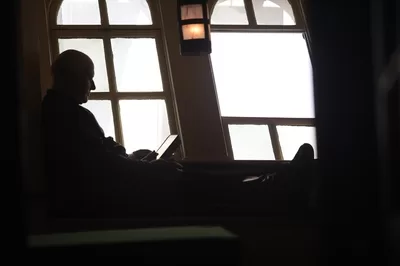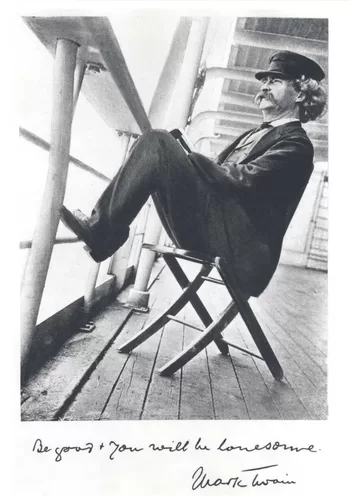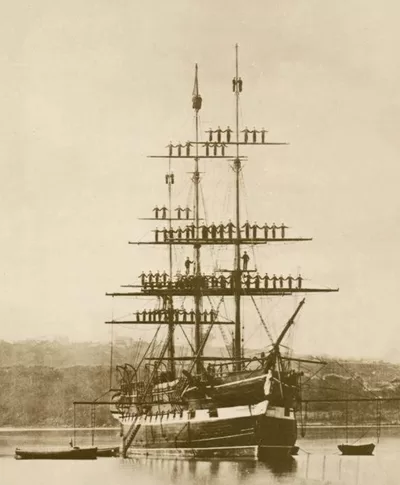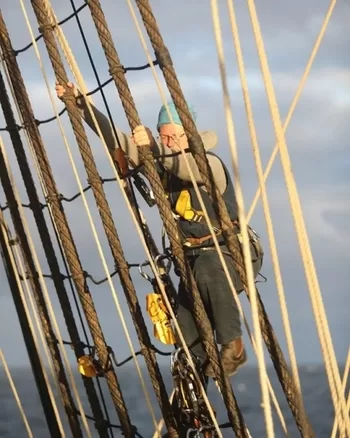Lt James Cook’s journal entries Friday, 20-28th April 1770, sailing north from Point Hicks to Botany Bay (Kamay) during his First Voyage in H.M Bark “Endeavour” 1768-71.
The captain and crew aboard His Majesty’s Bark Endeavour would have been very excited this week, 20th – 28th April, 1770. After sailing halfway around the world, they had made landfall the previous day and were the first British sailors to see what is now the east coast of Australia. Lt James Cook’s historic first sighting on the 19th April 1770 at Point Hicks is documented here.
During this week, the HMB Endeavour makes her way along the coast, seeing camp fire smoke on many occasions, “a Certain sign that the Country is inhabited” and “were so near the Shore as to distinguish several people upon the Sea beach”, his first sighting of the First Nation people of Australia. “They appeared to be of a very dark or black Colour” Cook wrote.
During this week Cook gave English names to Cape Howe, Mount Dromedary, Cape Dromedary, Pigeon house, Cape St. George, Long Nose, Red Point.
On the 28th April, Cook attempts a landing near what is now called Bulli, then makes his way to Botany Bay – Kamay. …
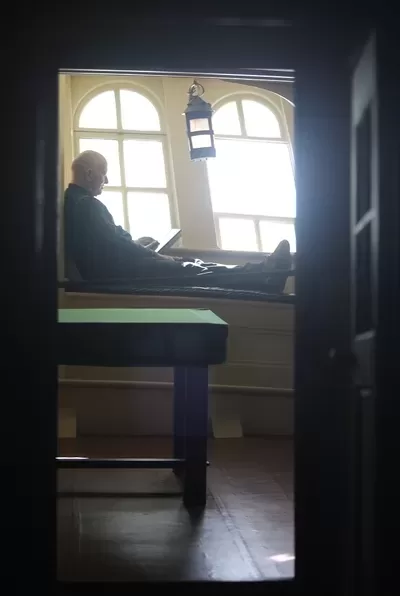

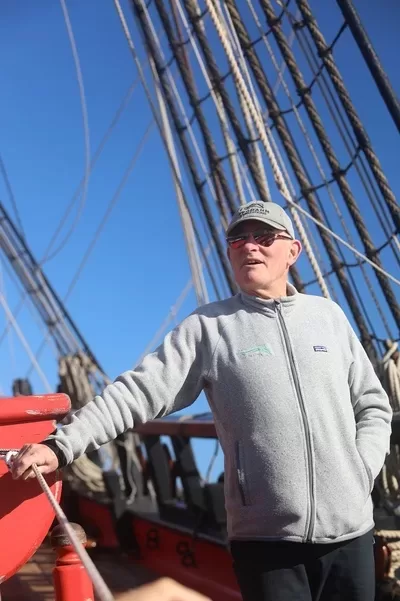

Captain Frank Allica, HMB Endeavour. A pleasure sailing with you, sir!
© 2019 Mark Anning photo
Lt James Cook’s journal 20th April 1770 – “a very agreeable and promising aspect”
Friday, 20th. In the P.M. and most part of the night had a fresh Gale Westerly, with Squalls, attended with Showers of rain. In the A.M. had the Wind at South-West, with Severe weather.
At 1 p.m. saw 3 Water Spouts at once; 2 were between us and the Shore, and one at some distance upon our Larboard Quarter.
At 6, shortned sail, and brought too for the Night, having 56 fathoms fine sandy bottom. The Northermost land in sight bore North by East 1/2 East, and a small Island* lying close to a point on the Main bore West, distant 2 Leagues. (* Gabo Island.)
This point I have named Cape Howe*; it may be known by the Trending of the Coast, which is North on the one Side and South-West on the other. Latitude 37 degrees 28 minutes South; Longitude 210 degrees 3 minutes West. (* Cape Howe, called after Admiral Earl Howe, is the south-east point of Australia. The position is almost exact.)
It may likewise be known by some round hills upon the main just within it. Having brought too with her head off Shore, we at 10 wore, and lay her head in until 4 a.m., at which time we made sail along shore to the Northward.
At 6, the Northermost land in sight bore North, being at this time about 4 Leagues from the Land. At Noon we were in the Latitude of 36 degrees 51 minutes South and Longitude of 209 degrees 53 minutes West, and 3 Leagues from the land.
Course sail’d along shore since Yesterday at Noon was first North 52 degrees East, 30 miles, then North by East and North by West, 41 Miles.
The weather being clear gave us an opportunity to View the Country, which had a very agreeable and promising aspect, diversified with hills, ridges, plains, and Valleys, with some few small lawns; but for the most part the whole was covered with wood, the hills and ridges rise with a gentle slope; they are not high, neither are there many of them.
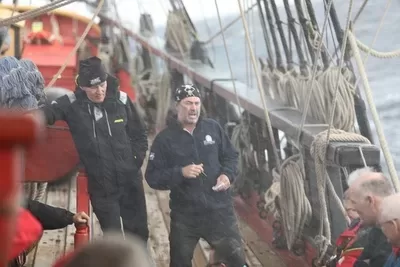

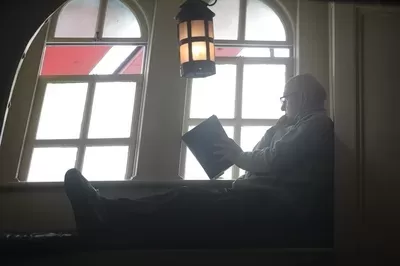

Captain Frank Allica, HMB Endeavour. © 2019 Mark Anning photos
[Off Cape Dromedary, New South Wales]
James Cook’s journal 21st April 1770 – “Certain sign that the Country is inhabited”
Saturday, 21st. Winds Southerly, a Gentle breeze, and Clear weather, with which we coasted along shore to the Northward.
In the P.M. we saw the smoke of fire in several places; a Certain sign that the Country is inhabited.
At 6, being about 2 or 3 Leagues from the land, we shortned Sail, and Sounded and found 44 fathoms, a sandy bottom.
Stood on under an easey sail until 12 o’Clock, at which time we brought too until 4 A.M., when we made sail, having then 90 fathoms, 5 Leagues from the land. At 6, we were abreast of a pretty high Mountain laying near the Shore, which, on account of its figure, I named Mount Dromedary (Latitude 36 degrees 18 minutes South, Longitude 209 degrees 55 minutes West).
The shore under the foot of the Mountain forms a point, which I have named Cape Dromedary, over which is a peaked hillock.
At this time found the Variation to be 10 degrees 42 minutes East. Between 10 and 11 o’Clock Mr. Green and I took several Observations of the Sun and Moon, the mean result of which gave 209 degrees 17 minutes West Longitude from the Meridian of Greenwich. By observation made yesterday we were in the Longitude 210 degrees 9 minutes.
West 20 minutes gives 209 degrees 49 minutes the Longitude of the Ship to-day at noon per yesterday’s observation, the Mean of which and to-day’s give 209 degrees 33 minutes West, by which I fix the Longitude of this Coast.
Our Latitude at Noon was 35 degrees 49 minutes South; Cape Dromedary bore South 30 degrees West, distant 12 Leagues.
An Open Bay* wherein lay 3 or 4 Small Islands, bore North-West by West, distant 5 or 6 Leagues. This Bay seem’d to be but very little Shelter’d from the Sea Winds, and yet it is the only likely Anchoring place I have yet seen upon the Coast. (* Bateman Bay)
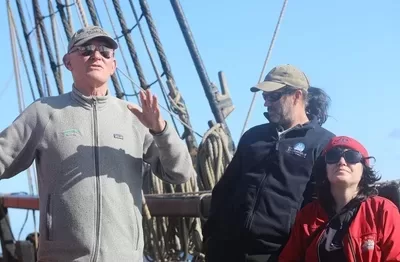

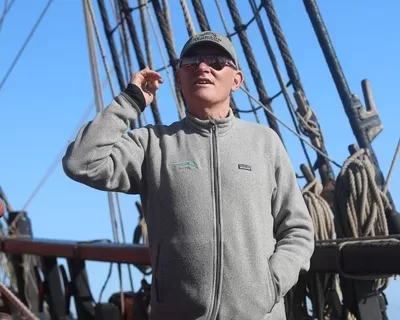

Captain Frank Allica, HMB Endeavour. © 2019 Mark Anning photos
Cook and his crew see smoke from camp fires and bring the HMB Endeavour close enough to land to see people, and begin to look for a safe place to land.
James Cook’s journal entry 22nd April 1770 – “appeared to be of a very dark or black Colour”
Sunday, 22nd. In the P.M. had a Gentle breeze at South by West with which we steer’d along shore North by East and North-North-East at the distance of about 3 Leagues.
Saw the smoke of fire in several places near the Sea beach.
At 5, we were abreast of a point of land which, on account of its perpendicular Clifts, I call’d Point Upright; Latitude 35 degrees 35 minutes South; it bore from us due West, distant 2 Leagues, and in this Situation had 31 fathoms, Sandy bottom.
At 6, falling little wind, we hauld off East-North-East; at this time the Northermost land in sight bore North by East 1/2 East, and at midnight, being in 70 fathoms, we brought too until 4 A.M., at which time we made sail in for the land, and at daylight found ourselves nearly in the same Place we were at 5 o’Clock in the evening, by which it was apparent that we had been drove about 3 Leagues to the Southward by a Tide or Current in the night.
After this we steer’d along shore North-North-East, having a Gentle breeze at South-West, and were so near the Shore as to distinguish several people upon the Sea beach.
They appeared to be of a very dark or black Colour; but whether this was the real Colour of their skins or the Cloathes they might have on I know not.
At Noon we were by Observation in the Latitude of 35 degrees 27 minutes and Longitude 209 degrees 23 minutes; Cape Dromedary bore South 28 degrees West, distance 15 Leagues.
A remarkable peak’d hill laying inland, the Top of which looked like a Pigeon house, and occasioned my giving it that name, bore North 32 degrees 33 minutes West, and a small low Island, laying close under the Shore, bore North-West, distance 2 or 3 Leagues; Variation of the Compass 9 degrees 50 minutes East.
When we first discover’d this Island in the morning I was in hopes, from its appearance, that we should have found Shelter for the Ship behind it; but when we came to approach it near I did not think that there was even security for a Boat to land.
But this, I believe, I should have attempted had not the wind come on Shore, after which I did not think it safe to send a Boat from the Ship, as we had a large hollow Sea from the South-East rowling in upon the land, which beat every where very high upon the Shore; and this we have had ever since we came upon the Coast.
The land near the Sea coast still continues of a moderate height, forming alternately rocky points and Sandy beaches; but inland, between Mount Dromedary and the Pigeon house, are several pretty high Mountains, 2 only of which we saw but what were covered with Trees, and these lay inland behind the Pigeon House, and are remarkably flat a Top, with Steep rocky clifts all round them.
As far as we could see the Trees in this Country hath all the appearance of being stout and lofty. For these 2 days past the observed Latitude hath been 12 or 14 Miles to the Southward of the Ship’s account given by the Log, which can be owing to nothing but a Current set to the Southward.

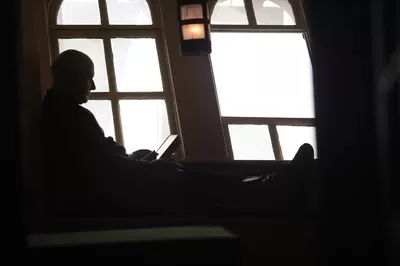

Captain Frank Allica, HMB Endeavour. © 2019 Mark Anning photo
James Cook’s journal 23rd April 1770 – “a Gentle breeze”
Monday, 23rd. In the P.M. had a Gentle breeze at East, which in the night veer’d to North-East and North. At 1/2 past 4 P.M., being about 5 Miles from the Land, we Tack’d and stood off South-East and East until 4 A.M., at which time we Tack’d and stood in, being then about 9 or 10 Leagues from the land. At 8, it fell little wind, and soon after Calm.
At Noon we were by Observation in the Latitude of 35 degrees 38 minutes and about 6 Leagues from the land, Mount Dromedary bearing South 37 degrees West, distant 17 Leagues, and the Pidgeon house North 40 degrees West; in this situation had 74 fathoms.
| From BOOKTOPIA Australia The Journals of Captain Cook Penguin Classics By: James Cook | From Amazon USA |
James Cook’s journal 24th April 1770 – “land which I named Cape St. George”
Tuesday, 24th. In the P.M. had Variable light Airs and Calms until 6 o’Clock, at which time a breeze sprung up at North by West; at this time we had 70 fathoms Water, being about 4 or 5 Leagues from the land, the Pidgeon house bearing North 40 degrees West, Mount Dromedary South 30 degrees West, and the Northermost land in sight North 19 degrees East.
Stood to the North-East until Noon, having a Gentle breeze at North-West, at which time we Tack’d and stood to the Westward, being then, by observation, in the Latitude of 35 degrees 10 minutes South and Longitude 208 degrees 51 minutes West.
A point of land which I named Cape St. George, we having discovered it on that Saint’s day, bore West, distant 19 Miles, and the Pidgeon house South 7 degrees West, the Latitude and Longitude of which I found to be 35 degrees 19 minutes South and 209 degrees 42 minutes West.
In the morning we found the Variation to be, by the Amplitude, 7 degrees 50 minutes East, by several Azimuths 7 degrees 54 minutes East.
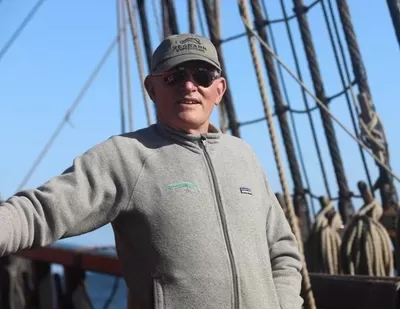

Captain Frank Allica, HMB Endeavour. A pleasure sailing with you, sir!
© 2019 Mark Anning photo
James Cook’s journal 25th April 1770 – “we saw the Smoke of fire”
[Off Jervis Bay, New South Wales.]
Wednesday, 25th. In the P.M. had a fresh breeze at North-West until 3 o’Clock, at which time it came to West, and we Tack’d and stood to the Northward.
At 5 o’Clock, being about 5 or 6 Leagues from the land, the Pidgeon house bearing West-South-West, distant 9 Leagues, sounded and had 86 fathoms.
At 8, being very squally, with lightning, we close reef’d the Topsails and brought too, being then in 120 fathoms.
At 3 A.M. made sail again to the Northward, having the advantage of a fresh Gale at South-West. At Noon we were about 3 or 4 Leagues from the land and in the Latitude of 34 degrees 22 minutes and Longitude 208 degrees 36 minutes West. Course and distance sail’d since Yesterday noon is North by East 49 Miles.
In the Course of this day’s run we saw the Smoke of fire in several places near the Sea beach.
About 2 Leagues to the Northward of Cape St. George the Shore seems to form a bay,* (* Jervis Bay, a very fine port, but little use has been made of it up to the present time.) which appear’d to be shelter’d from the North-East winds; but as we had the wind it was not in my power to look into it, and the appearance was not favourable enough to induce me to loose time in beating up to it.
The North point of this bay, on account of its Figure, I nam’d Long Nose. Latitude 45 degrees 4 minutes South, 8 Leagues to the Northward of this, is a point which I call’d Red Point; some part of the Land about it appeared of that Colour (Latitude 34 degrees 29 minutes South, Longitude 208 degrees 49 minutes West).
A little way inland to the North-West of this point is a round hill, the top of which look’d like the Crown of a Hatt.






Captain Frank Allica, HMB Endeavour. © 2019 Mark Anning photo
James Cook’s journal 26th April 1770 “Saw several smokes along shore before dark”
Thursday, 26th. Clear, serene weather. In the P.M. had a light breeze at North-North-West until 5, at which time it fell Calm, we being then about 3 or 4 Leagues from the land and in 48 fathoms. Variation by Azimuth 8 degrees 48 minutes East, the extreams of the land from North-East by North to South-West by South.
Saw several smokes along shore before dark, and 2 or 3 times a fire.
In the Night we lay becalm’d, driving in before the Sea, until one o’Clock A.M., at which time we got a breeze from the land, with which we steer’d North-East, being then in 38 fathoms water.
At Noon it fell little Wind, and veer’d to North-East by North, we being then in the Latitude of 34 degrees 10 minutes and Longitude 208 degrees 27 minutes West, and about 5 Leagues from the land, which extended from South 37 degrees West to North 1/2 East.
In this Latitude are some White Clifts, which rise perpendicular from the Sea to a moderate height.





Captain Frank Allica in the Great Cabin, HMB Endeavour. © 2019 Mark Anning photo
James Cook’s journal 27th April 1770 “we tack’d and stood off”
Friday, 27th. Var’ble light Airs between the North-East and North-West, clear pleasant weather. In the P.M. stood off Shore until 2, then Tackt and Stood in till 6, at which time we tack’d and stood off, being then in 54 fathoms and about 4 or 5 miles from the land, the Extreams of which bore from South, 28 degrees West to North 25 degrees 30 minutes East.
At 12 we tack’d and stood in until 4 A.M., then made a Trip off until day light, after which we stood in for the land; in all this time we lost ground, owing a good deal to the Variableness of the winds, for at Noon we were by Observation in the Latitude of 34 degrees 21 minutes South, Red Point bearing South 27 degrees West, distant 3 Leagues.
In this Situation we were about 4 or 5 Miles from the land, which extended from South 19 degrees 30 minutes West to North 29 degrees East.





Captain Frank Allica, HMB Endeavour. © 2019 Mark Anning photo
Lt James Cook’s journal 28th April 1770 “we discover’d a Bay”
Saturday, 28th. In the P.M. hoisted out the Pinnace and Yawl in order to attempt a landing, but the Pinnace took in the Water so fast that she was obliged to be hoisted in again to stop her leakes.
At this time we saw several people a shore, 4 of whom where carrying a small Boat or Canoe, which we imagin’d they were going to put in to the Water in order to Come off to us; but in this we were mistaken.
Being now not above 2 Miles from the Shore Mr. Banks, Dr. Solander, Tupia, and myself put off in the Yawl, and pull’d in for the land to a place where we saw 4 or 5 of the Natives, who took to the Woods as we approached the Shore; which disappointed us in the expectation we had of getting a near View of them, if not to speak to them.
But our disappointment was heightened when we found that we no where could effect a landing by reason of the great Surf which beat everywhere upon the shore.
We saw haul’d up upon the beach 3 or 4 small Canoes, which to us appeared not much unlike the Small ones of New Zeland.
In the wood were several Trees of the Palm kind, and no under wood; and this was all we were able to observe from the boat, after which we return’d to the Ship about 5 in the evening.*
(* The place where Cook attempted to land is near Bulli, a place where there is now considerable export of coal. A large coal port, Wollongong, lies a little to the southward.)
At this time it fell Calm, and we were not above a Mile and a half from the Shore, in 11 fathoms, and within some breakers that lay to the Southward of us; but luckily a light breeze came off from the Land, which carried us out of danger, and with which we stood to the Northward.
At daylight in the morning we discover’d a Bay,* which appeared to be tollerably well shelter’d from all winds, into which I resolved to go with the Ship, and with this View sent the Master in the Pinnace to sound the Entrance, while we keept turning up with the Ship, having the wind right out. At noon the Entrance bore North-North-West, distance 1 Mile. (* Botany Bay – Kamay)
°°°
The next journal entries: Lt James Cook goes ashore in Botany Bay. In Dharawal language, it is known as Kamay.
Lt James Cook’s historic first sighting on the 19th April 1770 at Point Hicks.
Read Captain Cook’s journal –
1. James Cook aboard His Majesty’s Bark Endeavour first sight of Australia at Point Hicks
2. James Cook journal: 20th – 28th April, 1770 on HMB Endeavour From Pt. Hicks to Kamay Botany Bay

